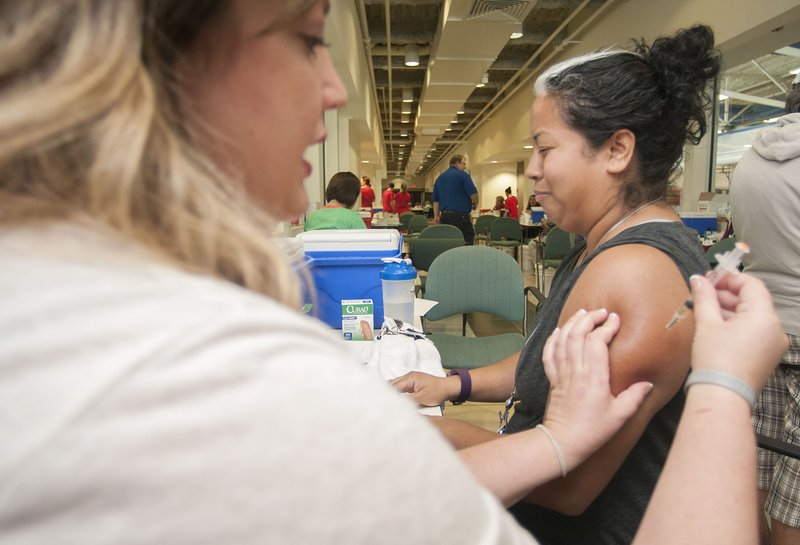The spread of one of the country's largest mumps outbreaks in recent years has slowed to its most sluggish pace since it began in August, according to the Arkansas Department of Health.
March so far has brought an average of about two new cases per day, the department's running tally shows, compared to a mid-November rate 16 times as high.
Mumps vaccine recommendations
• For children younger than 6, one dose at age 12-15 months, followed by a second dose at age 4-6 years.
• For children 7 through 18 not previously vaccinated, one dose followed by a second dose at least four weeks after the first.
• For adults born in 1957 or later and not previously vaccinated, one dose. A second dose is recommended for adults born in 1957 or later who are students in a post-secondary educational institution, work in a health care facility or plan to travel internationally. The second dose should be administered at least 28 days after the first.
Source: Arkansas Department of Health
Cities and school districts in more than 30 counties had active cases at the outbreak's peak. Six counties had cases as of Thursday.
The slower pace is still abnormal compared to typical years in which only a handful of people throughout the state show symptoms of the virus. The outbreak has brought aches and fevers, swollen salivary glands and other symptoms to almost 3,000 Arkansans in all, most of them school-age children. Arkansas has seen roughly half of the country's cases counted by the federal Centers for Disease Control and Prevention since the beginning of 2016.
"We were real worried, when we started to see it spread out geographically, that it would begin to take hold somewhere," Dr. Dirk Haselow, state epidemiologist, said late last month. "Knock on wood" that hasn't happened, he added. "It's been very, very good."
The turning point appears to have come in late December, based on Health Department data. Two of Kejjo Clarence's four children showed signs of the virus about that time and had to be confined to their room for several days to prevent its spread through coughing and sneezing. Clarence, president of a Marshallese Church of Latter-Day Saints in Springdale, said half of his 160 or so church members were staying home at one point.
"Now it's almost gone, and everyone's feeling good," he said.
Springdale was the epicenter of an outbreak the department said seemed to have been sparked by a visitor from Iowa, which has been experiencing its own outbreak for months. Dozens of schools saw cases, meaning children who weren't fully vaccinated because of religious or medical reasons or their parents' preference had to stay home for almost a month under state law. The virus can hide for around 26 days in the body.
Springdale Public Schools spokesman Rick Schaeffer said what was once a weekly topic at administration meetings hadn't come up in "quite a while."
"We hope they don't return ever," he said of the mumps with a laugh.
Mumps has no treatment to shorten its course, but two doses of a vaccine developed about five decades ago can protect about 9 in 10 people who are exposed to the virus, according to the disease control centers. The unlucky person who still catches it despite immunization would experience less severe symptoms as well, the Health Department has found.
Almost all children and about one-third of adults who caught the virus were vaccinated, so the department has been studying whether the vaccine is less effective against this particular variety of mumps and whether people need a third dose or booster to get the expected protection. The results won't be ready until the outbreak officially ends, but have been promising so far, Haselow said.
A third dose cut infection rates in half at workplaces or schools in the 26 days following their first cases, he said. After 26 days, groups with third doses had no new cases.
"That is fantastic," Haselow said. "What that doesn't demonstrate is whether that intervention is cost-effective, and we are looking into that as well."
Meanwhile, the state will continue reaching out to adults who went through school before the two-dose vaccine became the norm to encourage them to get the shots, said Dr. Gary Wheeler, the department's chief medical officer.
A study published this week by researchers at Boston Children's University estimated about one-fifth of the people in Arkansas communities affected by the outbreak weren't vaccinated, leaving them vulnerable to the outbreak, though the number would be smaller if the vaccine turns out to be less effective.
The Health Department doesn't track the number of adults in the state who've been vaccinated. The federal centers recommend one or two doses for adults up to age 60, depending on their circumstances.
"We're making a lot of progress across the board, but these are major changes in the focus and practice of medicine," Wheeler said.
NW News on 03/26/2017
